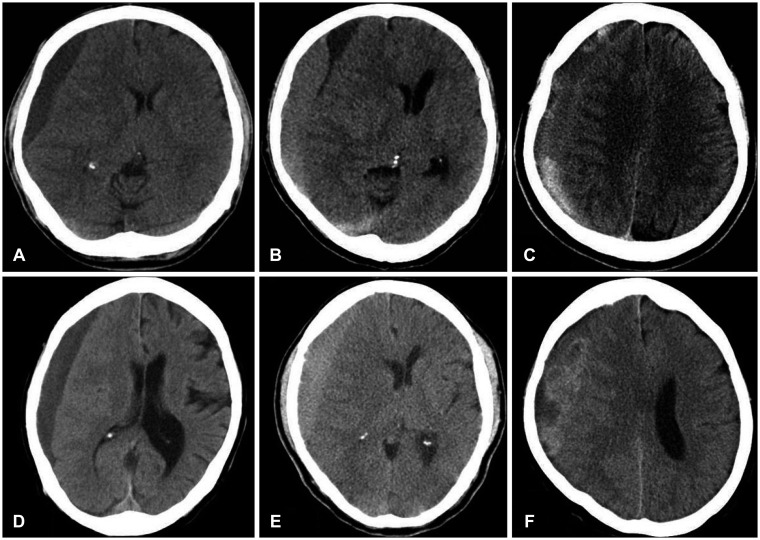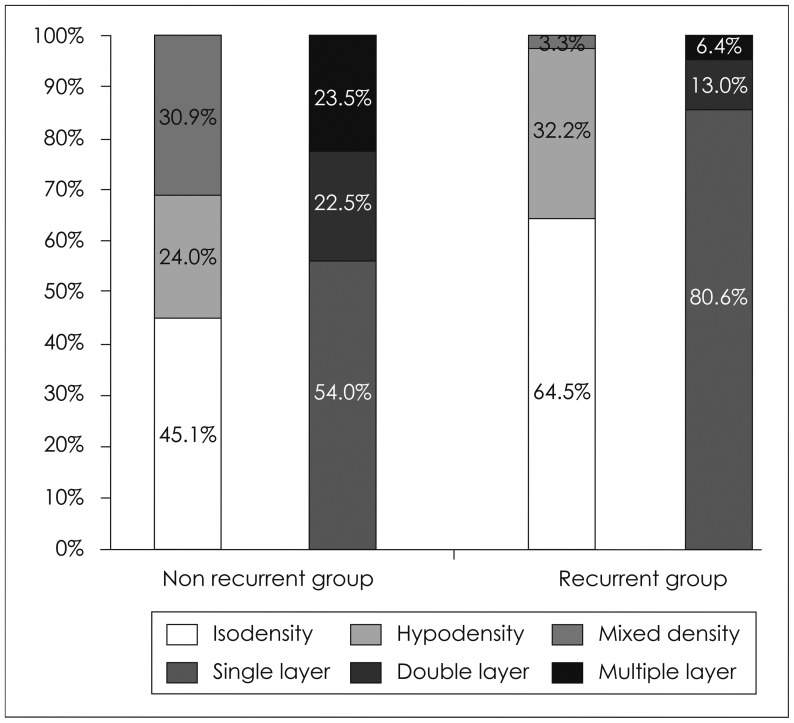Korean J Neurotrauma.
2015 Oct;11(2):63-69. 10.13004/kjnt.2015.11.2.63.
Risk Factor Analysis for the Recurrence of Chronic Subdural Hematoma: A Review of 368 Consecutive Surgical Cases
- Affiliations
-
- 1Department of Neurosurgery, Seoul National University Bundang Hospital, Seongnam, Korea. wanoh@snu.ac.kr
- KMID: 2378260
- DOI: http://doi.org/10.13004/kjnt.2015.11.2.63
Abstract
OBJECTIVE
Chronic subdural hematoma (CSDH) is a common form of extra axial hemorrhage in the elderly. A surgical procedures such as a burr hole trephination are used for the CSDH treatment. The recurrence rate of CSDH is reported to range from 2.3 to 33%. In the current study, we focused on the determination of risk factors associated with the recurrence of CSDH.
METHODS
We retrospectively reviewed 368 consecutive patients with CSDH treated by burr hole trephination. Univariate and multivariate analysis were performed to describe the relationships between clinical and radiological factors as well as the recurrence of CSDH.
RESULTS
Totally 31 (8.4%) patients experienced a recurrence of CSDH in our study. The male group (10.2%) had a higher recurrence rate than the female group (3.1%). Also patients with malignant neoplasm history showed a high recurrence rate (17.9%). The recurrence rate of single layer CSDH (13.1%) and isodensity CSDH (11.7%) was highly significant also.
CONCLUSION
Sex, history of malignant neoplasm and the hematoma type on computed tomography were factors related with the recurrence of CSDH in our study. These findings may be supportive in the identification of patients at risk for a recurrence of CSDH.
MeSH Terms
Figure
Cited by 1 articles
-
Heavily T2-Weighted Magnetic Resonance Myelography as a Safe Cerebrospinal Fluid Leakage Detection Modality for Nontraumatic Subdural Hematoma
Sungjae An, Han-Gil Jeong, Dongwook Seo, Hyunjun Jo, Si Un Lee, Jae Seung Bang, Chang Wan Oh, Tackeun Kim
J Korean Neurosurg Soc. 2022;65(1):13-21. doi: 10.3340/jkns.2020.0326.
Reference
-
1. Abdulhamid MM, Li YM, Hall WA. Spontaneous acute subdural hematoma as the initial manifestation of chronic myeloid leukemia. J Neurooncol. 2011; 101:513–516. PMID: 20582615.
Article2. Abouzari M, Rashidi A, Rezaii J, Esfandiari K, Asadollahi M, Aleali H, et al. The role of postoperative patient posture in the recurrence of traumatic chronic subdural hematoma after burr-hole surgery. Neurosurgery. 2007; 61:794–797. discussion 797PMID: 17986941.
Article3. Adhiyaman V, Asghar M, Ganeshram KN, Bhowmick BK. Chronic subdural haematoma in the elderly. Postgrad Med J. 2002; 78:71–75. PMID: 11807186.4. Barnabas O, Wang H, Gao XM. Role of estrogen in angiogenesis in cardiovascular diseases. J Geriatr Cardiol. 2013; 10:377–382. PMID: 24454332.5. Han HJ, Park CW, Kim EY, Yoo CJ, Kim YB, Kim WK. One vs. Two Burr Hole Craniostomy in Surgical Treatment of Chronic Subdural Hematoma. J Korean Neurosurg Soc. 2009; 46:87–92. PMID: 19763208.
Article6. Huang YH, Yang KY, Lee TC, Liao CC. Bilateral chronic subdural hematoma: what is the clinical significance? Int J Surg. 2013; 11:544–548. PMID: 23707986.
Article7. Kansal R, Nadkarni T, Goel A. Single versus double burr hole drainage of chronic subdural hematomas. A study of 267 cases. J Clin Neurosci. 2010; 17:428–429. PMID: 20202850.
Article8. Kimura S, Kotani A, Takimoto T, Yoshino A, Katayama Y. Acute aggravation of subdural fluid collection associated with dural metastasis of malignant neoplasms: case report and review of the literature. Brain Tumor Pathol. 2014; 31:299–303. PMID: 24036578.
Article9. Kostanian V, Choi JC, Liker MA, Go JL, Zee CS. Computed tomographic characteristics of chronic subdural hematomas. Neurosurg Clin N Am. 2000; 11:479–489. PMID: 10918018.
Article10. Kuan-Yin T, Dueng-Yuan H, Hsin-I M. Subdural hematoma associated with skull and dural metastasis of gastric carcinoma: a case report. Turk Neurosurg. 2013; 23:796–799. PMID: 24310465.
Article11. Laigle-Donadey F, Taillibert S, Mokhtari K, Hildebrand J, Delattre JY. Dural metastases. J Neurooncol. 2005; 75:57–61. PMID: 16215816.
Article12. Liwnicz BH, Wu SZ, Tew JM Jr. The relationship between the capillary structure and hemorrhage in gliomas. J Neurosurg. 1987; 66:536–541. PMID: 3031239.
Article13. Mori K, Maeda M. Surgical treatment of chronic subdural hematoma in 500 consecutive cases: clinical characteristics, surgical outcome, complications, and recurrence rate. Neurol Med Chir (Tokyo). 2001; 41:371–381. PMID: 11561347.
Article14. Nagatani K, Takeuchi S, Sakakibara F, Otani N, Nawashiro H. Radiological factors related to recurrence of chronic subdural hematoma. Acta Neurochir (Wien). 2011; 153:1713. PMID: 21347577.
Article15. Navi BB, Reichman JS, Berlin D, Reiner AS, Panageas KS, Segal AZ, et al. Intracerebral and subarachnoid hemorrhage in patients with cancer. Neurology. 2010; 74:494–501. PMID: 20142616.
Article16. Prasad BC, Chandra VV, Varaprasad G. Dural metastases in chronic myeloid leukemia presenting as subdural hematoma. Turk Neurosurg. 2012; 22:777–778. PMID: 23208914.
Article17. Rogers LR. Cerebrovascular complications in cancer patients. Neurol Clin. 2003; 21:167–192. PMID: 12690649.
Article18. Rozzelle CJ, Wofford JL, Branch CL. Predictors of hospital mortality in older patients with subdural hematoma. J Am Geriatr Soc. 1995; 43:240–244. PMID: 7884110.
Article19. Saito A, Narisawa A, Takasawa H, Morita T, Sannohe S, Sasaki T, et al. Expression of the TGF-β-ALK-1 pathway in dura and the outer membrane of chronic subdural hematomas. Neurol Med Chir (Tokyo). 2014; 54:357–362. PMID: 24305026.
Article20. Schrader B, Barth H, Lang EW, Buhl R, Hugo HH, Biederer J, et al. Spontaneous intracranial haematomas caused by neoplasms. Acta Neurochir (Wien). 2000; 142:979–985. PMID: 11086806.
Article21. Spallone A, Giuffrè R, Gagliardi FM, Vagnozzi R. Chronic subdural hematoma in extremely aged patients. Eur Neurol. 1989; 29:18–22. PMID: 2707288.
Article22. Stanišić M, Hald J, Rasmussen IA, Pripp AH, Ivanović J, Kolstad F, et al. Volume and densities of chronic subdural haematoma obtained from CT imaging as predictors of postoperative recurrence: a prospective study of 107 operated patients. Acta Neurochir (Wien). 2013; 155:323–333. discussion 333PMID: 23229873.
Article23. Taussky P, Fandino J, Landolt H. Number of burr holes as independent predictor of postoperative recurrence in chronic subdural haematoma. Br J Neurosurg. 2008; 22:279–282. PMID: 18348026.
Article24. Torihashi K, Sadamasa N, Yoshida K, Narumi O, Chin M, Yamagata S. Independent predictors for recurrence of chronic subdural hematoma: a review of 343 consecutive surgical cases. Neurosurgery. 2008; 63:1125–1129. discussion 1129PMID: 19008766.25. Tsai TH, Lieu AS, Hwang SL, Huang TY, Hwang YF. A comparative study of the patients with bilateral or unilateral chronic subdural hematoma: precipitating factors and postoperative outcomes. J Trauma. 2010; 68:571–575. PMID: 20065879.
Article
- Full Text Links
- Actions
-
Cited
- CITED
-
- Close
- Share
- Similar articles
-
- Erratum: Risk Factor Analysis for the Recurrence of Chronic Subdural Hematoma: A Review of 368 Consecutive Surgical Cases
- Chronic Subdural Hematoma Superimposed on Posttraumatic Subdural Hygroma: A Report of Three Cases
- Bilateral Acute Subdural Hematoma Following Evacuation of Chronic Subdural Hematoma
- The Technical Factors that Influence Recurrence of Chronic Subdural Hematoma: A Review of 140 Consecutive Surgical Cases
- Clinical Analysis of Recurrent Chronic Subdural Hematoma




